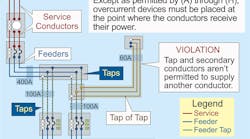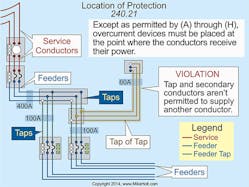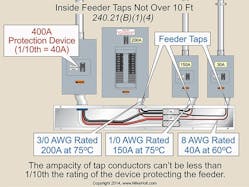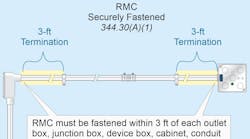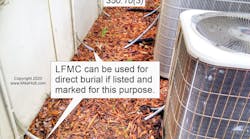Q. Where does the Code require overcurrent protection to be located in a circuit?
Find the Answer
A. Except as permitted by Sec. 240.21(A) through (H), overcurrent devices must be placed at the point where the branch-circuit or feeder conductors receive their power. Taps and transformer secondary conductors aren’t permitted to supply another conductor (tapping a tap isn’t permitted).
(A) Branch-circuit taps. Branch-circuit taps are permitted in accordance with Sec. 210.19.
(B) Feeder taps. Conductors can be tapped to a feeder as specified in Sec. 240.21(B)(1) through (B)(5). The “next size up protection rule” of 240.4(B) isn’t permitted for tap conductors.
240.21(B)(1) 10-ft feeder tap. Feeder tap conductors up to 10 ft long are permitted without overcurrent protection at the tap location if the tap conductors comply with the following:
(1) The ampacity of the tap conductor must not be less than:
a. The calculated load in accordance with Art. 220, and
b. The rating of the overcurrent device supplied by the tap conductors.
Exception: Listed equipment, such as a surge protection device, can have their conductors sized in accordance with the manufacturer’s instructions.
(2) The tap conductors must not extend beyond the equipment they supply.
(3) The tap conductors are installed in a raceway when they leave the enclosure.
(4) The tap conductors must have an ampacity not less than 10% of the rating of the overcurrent device that protects the feeder. Note: See Sec. 408.36 for the overcurrent protection requirements for panelboards.
240.21(B)(2) 25-foot feeder tap. Feeder tap conductors up to 25 ft long are permitted without overcurrent protection at the tap location if the tap conductors comply with the following:
(1) The ampacity of the tap conductors must not be less than one-third the rating of the overcurrent device that protects the feeder.
(2) The tap conductors terminate in an overcurrent device rated no more than the tap conductor ampacity in accordance with 310.15.
240.21(B)(5) outside feeder taps of unlimited length. Outside feeder tap conductors can be of unlimited length, without overcurrent protection at the point they receive their supply, if they comply with the following:
(1) The tap conductors are suitably protected from physical damage in a raceway or manner approved by the authority having jurisdiction.
(2) The tap conductors must terminate at a single circuit breaker or a single set of fuses that limits the load to the ampacity of the conductors.
(3) The overcurrent device for the tap conductors is an integral part of the disconnecting means, or it’s located immediately adjacent to it.
(4) The disconnecting means is located at a readily accessible location, either outside the building, or nearest the point of entry of the conductors.
(C) Transformer secondary conductors. A set of conductors supplying single or separate loads is permitted to be connected to a transformer secondary without overcurrent protection in accordance with (1) through (6). The permission of the “next size up” protection rule when the conductor ampacity doesn’t correspond with the standard size overcurrent protection device of 240.4(B) doesn’t apply to transformer secondary conductors.
(1) Protection by primary overcurrent device. The primary overcurrent device sized in accordance with Sec. 450.3(B) is considered suitable to protect the secondary conductors of a 2-wire (single-voltage) system, provided the primary overcurrent device doesn’t exceed the value determined by multiplying the secondary conductor ampacity by the secondary-to-primary transformer voltage ratio.
(2) 10-ft secondary conductors. Secondary conductors can be run up to 10 ft without overcurrent protection if installed as follows:
(1) The ampacity of the secondary conductor must not be less than:
a. The calculated load in accordance with Art. 220, and
b. The rating of the overcurrent device at the termination of the secondary conductors
Exception: Listed equipment, such as a surge protection device, can have their conductors sized in accordance with the manufacturer’s instructions.
(2) The secondary conductors must not extend beyond the switchboard, switchgear, panelboard, disconnecting means, or control devices they supply.
(3) The secondary conductors are enclosed in a raceway.
(4) Not less than 10% of the rating of the overcurrent device protecting the primary of the transformer, multiplied by the primary-to-secondary transformer voltage ratio.
(4) Outside secondary conductors of unlimited length. Outside secondary conductors can be of unlimited length, without overcurrent protection at the point they receive their supply, if they’re installed as follows:
(1) The conductors are suitably protected from physical damage in a raceway or manner approved by the authority having jurisdiction.
(2) The conductors must terminate at a single circuit breaker or a single set of fuses that limit the load to the ampacity of the conductors.
(3) The overcurrent device for the ungrounded conductors is an integral part of a disconnecting means or it’s located immediately adjacent thereto.
(4) The disconnecting means is located at a readily accessible location that complies with one of the following:
a. Outside of a building.
b. Inside, nearest the point of entrance of the conductors.
c. If installed in accordance with 230.6, nearest the point of entrance of the conductors.
(5) Secondary conductors from a feeder tapped transformer. Transformer secondary conductors must be installed in accordance with Sec. 240.21(B)(3).
(6) 25-ft secondary conductor. Secondary conductors can be run up to 25 ft without overcurrent protection if they comply with all of the following:
(1) The secondary conductors have an ampacity not less than the value of the primary-to-secondary voltage ratio multiplied by one-third of the rating of the overcurrent device that protects the primary of the transformer.
(2) Secondary conductors terminate in a single circuit breaker or set of fuses rated no more than the tap conductor ampacity in accordance with 310.15 [Table 310.15(B)(16)].
(3) The secondary conductors are protected from physical damage by being enclosed in a manner approved by the authority having jurisdiction, such as within a raceway.
(D) Service conductors. Service conductors must be protected against overload in accordance with Sec. 230.90 and Sec. 230.91.
(H) Battery conductors. Overcurrent protection is installed as close as practicable to the storage battery terminals.
Let’s run through an example problem to show you how the ten-foot tap rule works.
A 400A breaker protects a set of 500kcmil feeder conductors. There are three taps fed from the 500kcmil feeder that supply disconnects with 200A, 150A, and 30A overcurrent devices. What are the minimum size conductors for these taps?
• 200A disconnect: 3/0 AWG is rated 200A at 75°C, and is greater than 10% of the rating of the overcurrent device (400A).
• 150A disconnect: 1/0 AWG is rated 150A at 75°C, and is greater than 10% of the rating of the overcurrent device (400A).
• 30A disconnect: 8 AWG is rated 40A at 60°C. The tap conductors from the 400A feeder to the 30A overcurrent device can’t be less than 40A (10% of the rating of the 400A feeder overcurrent device).
Let’s run through another example to show you how the transformer secondary conductor tap rule works.
What’s the minimum size secondary conductor required for a 2-wire, 480V to 120V transformer rated 1.50kVA with 60°C terminals?
Primary current = VA ÷ E = 1,500VA ÷ 480V = 3.13A
Primary protection [450.3(B)] = 3.13A × 1.67
Primary protection [450.3(B)] = 5.22A, or 5A fuse
Secondary current = 1,500VA ÷ 120V = 12.50A
Answer: Secondary conductor = 12 AWG, rated 20A at 60°C, [Table 310.15(B)(16)]
The 5A primary overcurrent device can be used to protect 12 AWG secondary conductors because it doesn’t exceed the value determined by multiplying the secondary conductor ampacity by the secondary-to-primary transformer voltage ratio.
5A ≤ 20A × (120V ÷ 480V) = 20A × (0.25) = 5A
